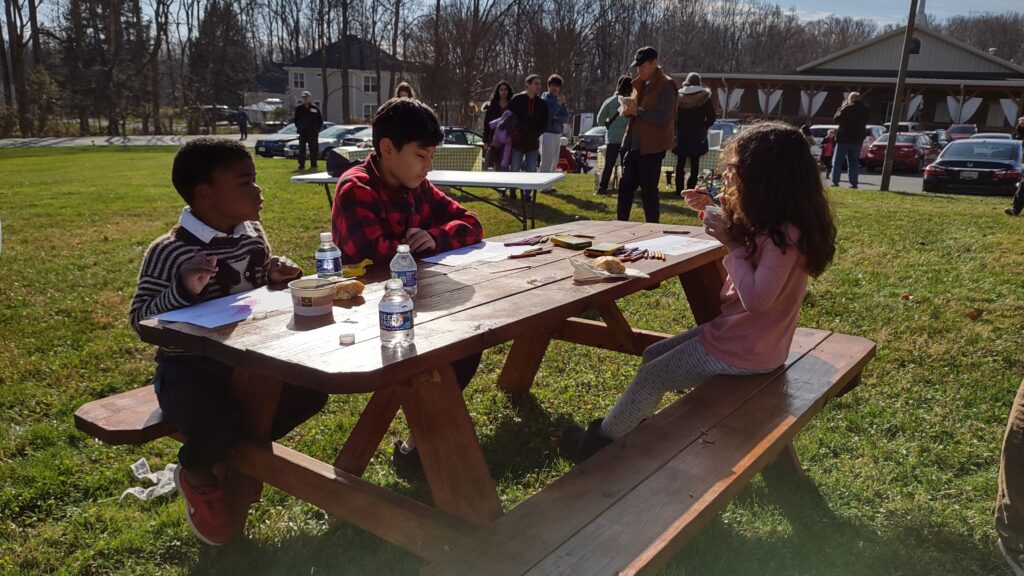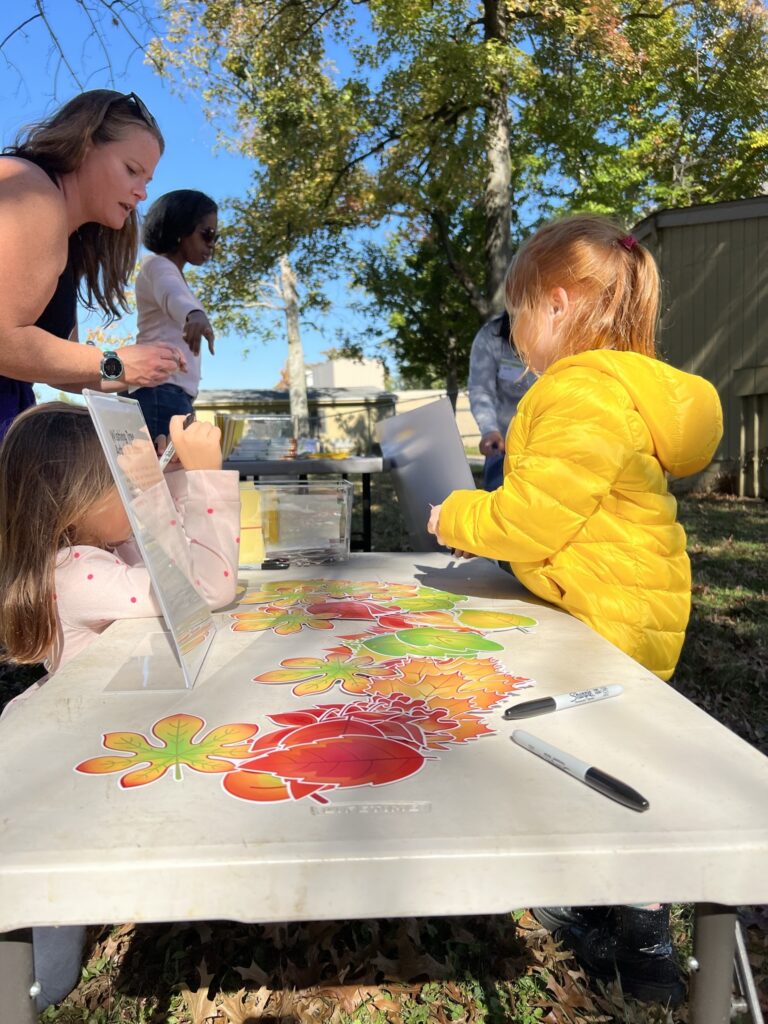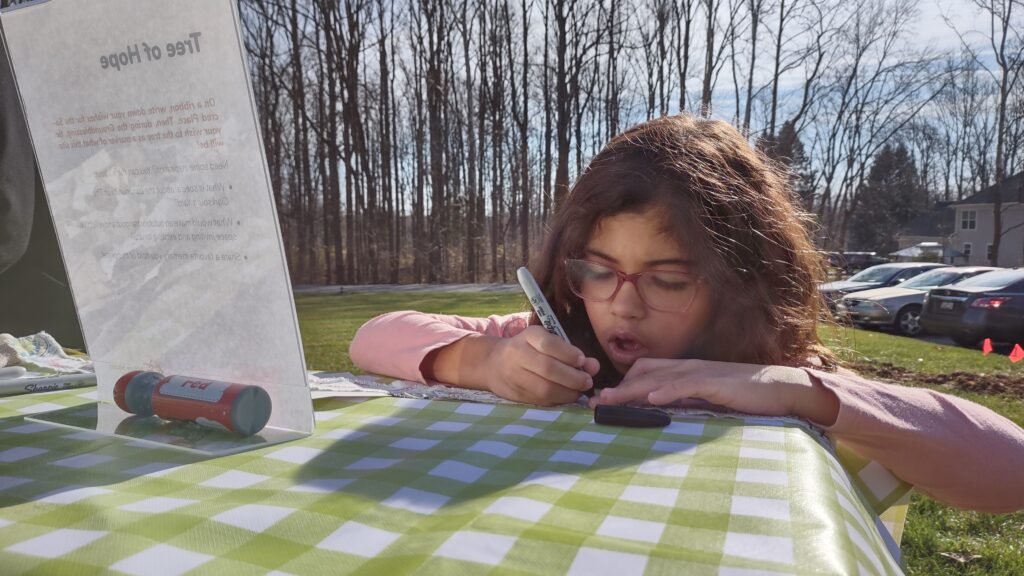
By Neha Srinivasan
Sr. Manager, Design & Sacred Places
Core to the goal of Nature Sacred’s landscape architecture work is to ensure that the designs we create are generated by the communities we work with. As we grow our footprint of sites, the groups of people we engage during the process is growing too, and not everyone can be optimally engaged with the same materials.
Children and young adults are two groups that benefit from customized materials to fully elicit their design ideas. We’ve done activities from seed plantings and coloring pages to miniature landscape design studios. Here, I’ve highlighted three reasons engaging youth in design yields amazing results, spotlighting the approaches we’ve used at three different sites. The variety of activities we used, whether simple or complex, are all designed to elicit information that our Design Advisors incorporate into their work, even if on the surface, the activities seem like they’re just for fun.

If children and young adults are the end users of a space, then, just like any other community group, they need to have a say in how their space is designed.
The Sacred Place at Cesar Chavez Dual Spanish Immersion School (a public charter elementary school in Chillum, MD) will be a mid-sized space that sits in the crook of the L produced by the school building: visible from many of the school windows and easily accessible for programming. Since one of the space’s intentions is to create an outdoor classroom for the students, we wanted to ask the students directly what they wanted to see in that space. First, we oriented charrette 1 entirely around them: for example, with customized existing conditions coloring pages that they could modify with stickers and drawings of things they wanted to see in their Sacred Place, and an activity where students could plant seeds to take home and grow. We still use coloring pages in our non-student charrettes, because we’ve found adults like doing them too.
Next, in place of charrette 2, three of the teachers at the school created a curriculum for each grade, aligned with each grade’s STEM standards, and oversaw its implementation: a weeklong series of activities that resulted in designs of shade structures, gardens, [insert the others] by the students. EnviroCollab, our landscape architects, were then able to take all these materials, and incorporate the students’ thoughts so directly that their ideas are clearly visible in the end design, down to the name of the final Sacred Place, Wildcat Way, an homage to the school mascot.
Children and young adults are deeply inventive, with far fewer constraints on their creative thinking, and so the feedback you receive includes a much broader variety of design ideas.
Students are the primary end users at the Key School (a private K-12 school in Annapolis, MD) Sacred Place as well. Located on a busy thoroughfare between classes, this site is quite small. One of this space’s intentions is to be a place of refuge for students who need a moment to themselves. We met with a focus group of high school students on a rain-drenched June day, all of whom had made time to be there over their lunch hour. In that short time, they told us everything we needed to know to give them a whimsical, practical site. We walked down to the site when the rain had stilled to make observations live, and no sooner had we gotten there than their ideas started ticking away. They asked lots of questions about landscape design, made notes, sat down and swapped ideas with each other, and in no time had determined the key needs of their site: multiple seating locations so that, for example, a group eating lunch together could share the space with someone who was trying to have a quiet moment; bright colors with four-season interest, and keeping an existing tree stump.
And, as the designer for this site, I can say that the input from the students made my job quite simple. They told me everything I needed to add. All I had to do then was get everything to fit cohesively—which I did by overlaying my own concept of natural geometries, inspired by planetary orbit ellipticals and braided river systems. I hope that as they experience the design mature, that they will find confidence in the fact that they designed it, as being asked to design a space is often intimidating.
When it came time to plant, many of the perennials were planted by the students themselves, kindergarteners working with high school and middle school students, including some of the same ones who had participated in the focus group. Later, given the proximity of the site to the kindergarten classrooms, those students worked to incorporate fairy garden elements into the site: a way to give the younger children a reason to interact with their natural environments.
If building a sense of ownership early on is what makes a Sacred Place endure, then designing with children and young adults is crucial to that step.
At Stillmeadow PeacePark (Baltimore, MD), a 10-acre urban forest, the engagement of young adults is even more intrinsic to the park’s ongoing creation. Their Canopy Crew, a group of high school students who regularly volunteer at the park, chooses what needs to happen at different areas of the park, implements those changes, and stewards those changes. They have a high degree of autonomy in this, earned by their dedication and the level of expertise they have gained in ecological stewardship through their engagement here. When the Canopy Crew heard that landscape architects would be involved in creating a master plan for the PeacePark, they expressed interest in understanding what a landscape architect’s work entails and how it would manifest in their park, so over the course of a Saturday morning, I ran through a landscape architect’s entire design process, almost like a miniature landscape design studio (a design class structured like an independent workshop): from investigations of ecological and social connectivity through aerial maps at various scales, to site inventory and analysis, to quick timed sketches of what they would do at a specific location in the park.
 The Canopy Crew, as both existing and future stakeholders of the PeacePark, will be the ones taking care of the plans for the park as they are implemented, and so taking the time to ensure they understood the purpose of the work Nature Sacred is doing with Stillmeadow is key to ensuring they will also be invested in its maintenance. Additionally, this work has incited an interest in green jobs for several of the youth on the Canopy Crew, so providing them with a peephole into landscape architecture, an allied field, could spark an interest for some of them, or at least build their awareness of the potential career pathways available to them.
The Canopy Crew, as both existing and future stakeholders of the PeacePark, will be the ones taking care of the plans for the park as they are implemented, and so taking the time to ensure they understood the purpose of the work Nature Sacred is doing with Stillmeadow is key to ensuring they will also be invested in its maintenance. Additionally, this work has incited an interest in green jobs for several of the youth on the Canopy Crew, so providing them with a peephole into landscape architecture, an allied field, could spark an interest for some of them, or at least build their awareness of the potential career pathways available to them.
The first part of the design process (after you understand the site itself, of course) is to generate as many ideas as possible, under the principle that your first idea can’t be your best. It took a lot of work for me in my landscape architecture studio classes to learn how to follow this principle, to iterate and discard ideas—somewhere, that capacity to generate multitudes of ideas—and to not be afraid of discarding them just as fast—had gotten turned off.
As landscape architects serving communities, I see our role as offering not only what communities need in their spaces, but also elements they might not think or dare to dream for themselves—a broader net than is often cast by the communities we are working with, who may sometimes be focused—and rightly so—on the elements they most direly need.
Children and young adults have no such filters on their iteration, and they usually see things that could be unhampered by what has been, all with a great deal of maturity and perspicacity, which makes them an excellent way for designers to understand the heart of a community’s issues and the full creative range of potential solutions.

